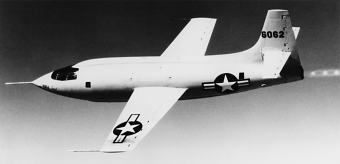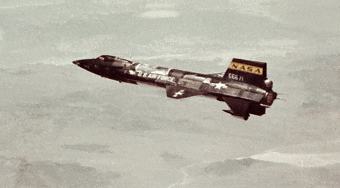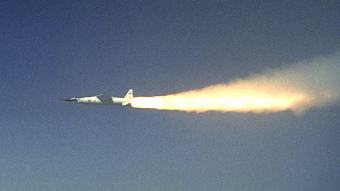

 The Research Airplane Program was a joint effort by the National Advisory Committee for Aeronautics (NACA, the predecessor of the National Aeronautics and Space Administration) and the military services. It was conceived near the end of Word War II to perform flight research with a series of specialized aircraft in the then-unexplored realms of transonic and supersonic flight.
The Research Airplane Program was a joint effort by the National Advisory Committee for Aeronautics (NACA, the predecessor of the National Aeronautics and Space Administration) and the military services. It was conceived near the end of Word War II to perform flight research with a series of specialized aircraft in the then-unexplored realms of transonic and supersonic flight.
Two general categories of aircraft were obtained for the project. They included those needed to explore new areas of performance and those required to investigate the effects of different airplane configurations. The project resulted in notable increases in knowledge about the dynamics of piloted flight in winged aircraft at speeds up to 4,500 miles per hour and at altitudes exceeding 350,000 feet.
The outstanding contributions of the Research Airplane Program, and subsequent flight research projects, include providing important information on previously unexplored aircraft characteristics; validating transonic and supersonic wind-tunnel test data and analytical techniques; and providing confidence in the achievement of safe, controllable, transonic/supersonic flight.
The first aircraft in the series was specifically designed to explore the transonic region and breach the so-called "sound barrier." It was originally designated XS-1 to denote that it would be the first experimental sonic airplane. Later, the designation was shortened to X-1. Many research vehicles have since provided important data to scientists and aircraft designers. They have come to be known collectively as: The X-Planes.
 The "X" designation is used to denote piloted, autonomous, or remotely piloted aerospace vehicles designed for testing highly experimental configurations. Numerous piloted and unpiloted X-planes have been designated, including variations and rebuilt/modified airframes.
The "X" designation is used to denote piloted, autonomous, or remotely piloted aerospace vehicles designed for testing highly experimental configurations. Numerous piloted and unpiloted X-planes have been designated, including variations and rebuilt/modified airframes.
Arguably there are some aircraft that, by their nature, deserved X designations (such as the D-558-I and D-558-II, transonic/supersonic research planes; and the M2-F1, M2-F2, M2-F3, and HL-10 wingless lifting body vehicles). For other aircraft, a YF designation (Service Test, Fighter) would seem more appropriate, such as the X-32 and X-35 Joint Strike Fighter technology demonstrators. A few (notably the X-8, X-9, X-11, and X-12) were rockets and missiles, not easily categorized as "X-planes."
"X-plane" designations are part of the Mission Design Series (MDS) designation system. Assignment of such numbers is regulated by Department of Defense (DoD) Direction 4120.15, "Designation and Naming Defense Military Aerospace Vehicles," and under the same title for each service: Air Force Joint Instruction 16-401, Army Regulation 70-50, and Navy NAVAIRINST 8800.3A.
Headquarters Air Force Materiel Command Cataloging and Standardization Center (HQ AFMC/CASC) in Battle Creek, Michigan serves as the control point for DoD MDS designators and aerospace vehicle popular names and assigns such designations as requested. Headquarters U.S. Air Force (HQ USAF/XPPE) at the Pentagon in Washington, D.C. administers the MDS Designator Program for the DoD and exercises approval authority for all new MDS designations.
|
"The Military Departments must submit a written request for assignment of a distinctive MDS designator as early as possible in the development cycle. Coordinate requests with the Military Department point of contact and CASC as soon as possible to have an MDS designator assigned. CASC will assign and reserve the next available consecutive design number within each basic mission for new vehicles. Do not use MDS designators before approval. NOTE: Air Force agencies must coordinate MDS requests through the applicable system program office (SPO). CASC will assign the MDS designator and transmit the request to HQ USAF/XPPE for processing and approval." |
 X-1, X-1A, X-1B, X-1C, X-1D, X-1E, X-2, X-3, X-4, X-5, X-6, X-13, X-14A, X-14B, X-15, X-16, X-18, X-19, X-20, X-21, X-22A, X-24A, X-24B, X-24C, X-25, X-25A, X-25B, X-26A, X-26B, X-27, X-28, X-29, X-30, X-31, X-32A, X-32B, X-35A, X-35B, X-35C, X-44
X-1, X-1A, X-1B, X-1C, X-1D, X-1E, X-2, X-3, X-4, X-5, X-6, X-13, X-14A, X-14B, X-15, X-16, X-18, X-19, X-20, X-21, X-22A, X-24A, X-24B, X-24C, X-25, X-25A, X-25B, X-26A, X-26B, X-27, X-28, X-29, X-30, X-31, X-32A, X-32B, X-35A, X-35B, X-35C, X-44
X-7, X-8, X-9, X-10, X-11, X-12, X-17, X-23, X-33, X-34, X-36, X-37, X-38, X-39, X-40A, X-41, X-42, X-43A, X-43B, X-43C, X-43D, X-45A, X-45B, X-46, X-47, X-50
Some X-designations were assigned to planes that ultimately were not built. Some of these reached the mock-up stage and others were only "paper airplanes," never going beyond the design stage. Occasionally an X-designation was applied to an aircraft before that designation was officially assigned, leading to later confusion when an official MDS was assigned. Examples include the "X-35 Crew Return Vehicle" which was later officially designated X-38, and the "Lockheed Martin X-32 Joint Strike Fighter" concept mock-up which underwent extensive redesign before becoming the X-35 while X-32 was assigned to the Boeing JSF design.
